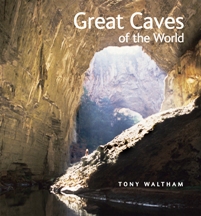 Great Caves of the World
Great Caves of the World
Tony Waltham
Published by: The Natural History Museum
Publication date: 25 September 2008
ISBN: 978-0-565-092160
List price: £14.99
112 pp
www.nhm.ac.uk
Measuring 26.7cm x 24.8cm and about 1.5cmsthick, this 112-page book contains a description of some of the world’s most spectacular natural underground cave systems illustrated with 74 impressive colour plates. This is a wonderful "coffee table" book for anyone with a small coffee table or a space to fill on a larger one.
Tony Waltham has selected 28 caves to describe and illustrate the processes and resulting features of natural erosion and deposition. Between interesting descriptions of the longest, largest, deepest and most beautiful caves are the tourist caves, just to demonstrate that this spectacular subterranean world is not only the haunt of experienced speleologists and “mad cavers”. However, it is clear from the photographs that a lot of effort goes into seeing in nature what is displayed in this book. There are caves with spectacular Neolithic paintings, underwater caves, caves under ice fields and deserts, and caves with beautiful lakes, giant entrances, grandiose caverns, and even fossil hominoids and statues of Buddha. If you were expecting 100% karst you are in for a surprise, as we are also treated to caves in gypsum, in salt and, for completeness, the world's longest drained lava tube (in a basaltic shield volcano of course).
The author has succeeded in conveying all the wonder and magnificence of vadose cave systems formed by running water, phreatic systems formed underwater and mixed cave systems due to rises and falls in the local water-table. Wonderful examples are provided of the classic cave formations (e.g. stalactites, stalagmites, columns, flowstone, rimstone pools, terraces, aragonite trees, gypsum chandeliers and cave pearls) plus more. I was particularly intrigued by the "snottite" bacterial mucus growths in Cueva de Villa Luz, Mexico. This karst cavity is fed not by meteoric water percolating down but by sulphurous geothermal water rising into the host limestone.
This is a fascinating glimpse into the subterranean world. Well written, wonderfully illustrated, perhaps missing a few location maps and some cave sections or a block diagram or two. A book thoroughly recommended for the "wow" factor, especially the 500m deep vadose shaft in the Miao Keng cave in China. Pause for a while at this and other plates and wonder not only about the effort it took to get to these subterranean locations, but also about the logistics and lighting sequences needed to capture them on camera!
Chris Carlon